Submitted by Berrin Chatzi Chousein
"Architecture Is A Profession Giving You Wide Limits Between You Can Oscillate" says Eva Jiřicna
Czech Republic Architecture News - Oct 26, 2019 - 13:35 8239 views

"Architecture is a profession giving you very wide limits between you can oscillate. And how determined the past between those limits, which are very widely spread, is up to you,” says Czech architect and co-founder and director of AI DESIGN Eva Jiřičná.
Architecture is always about the modesty and discipline, according to the acclaimed architect. Jiřičná believes that we should use technology to regenerate our way of living and she emphasizes that we shouldn’t be a victim of technology.
The acclaimed architect, who is behind the interiors of Lloyd’s Building in London, many retail and interior design projects, underlines that her architectural production and philosophy is still realized by hand and on a piece of paper. According to Jiřičná, technology must be involved in the design process after a certain phase.
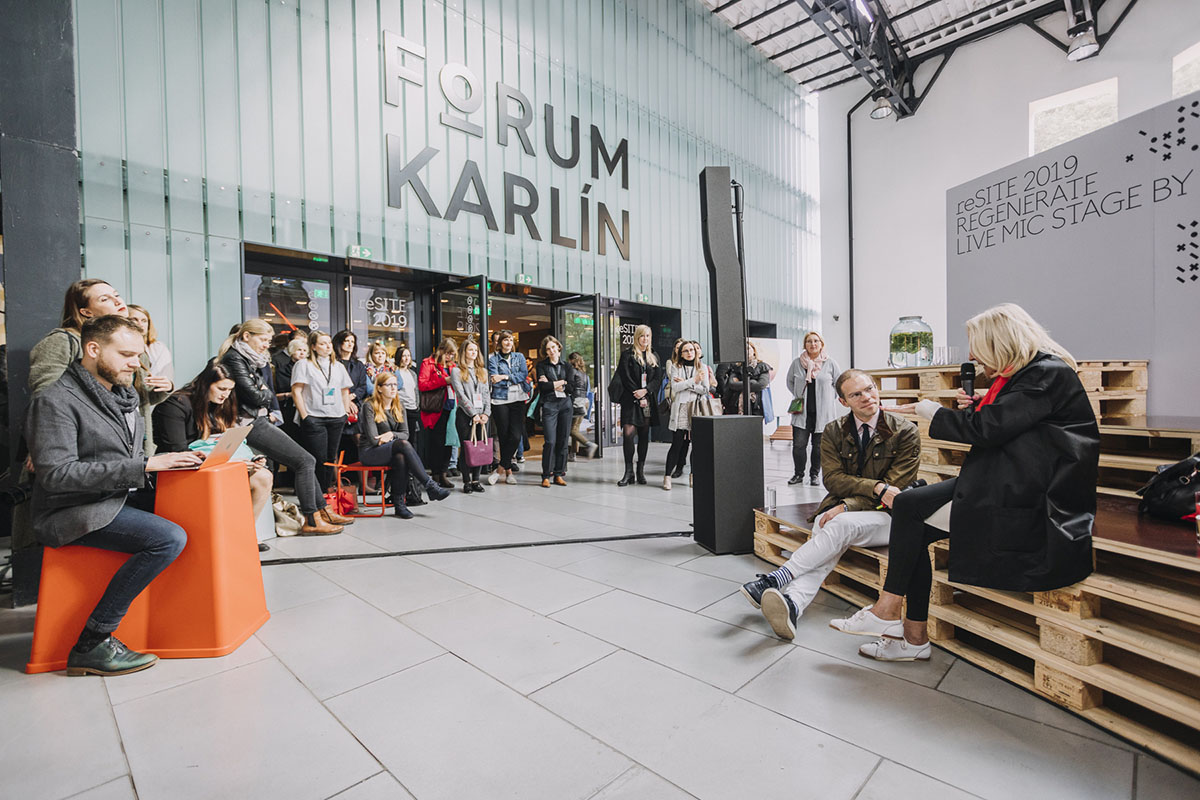
Eva Jiřičná in conversation with Greg Lindsay at reSITE 2019. Image © Jakub Cervenkai
Eva Jiřičná spoke to World Architecture Community in an exclusive interview at this year’s reSITE REGENERATE conference, held on September 19-20 in Prague – in which WAC is the official media partner of the event. The Czech architect talked about her move to London in the 1960s, her experience of working with Richard Rogers and the evolution of her own office until today.
In designing the future cities Jiřičná also stated that how today's architecture should incorporate in new technological developments, avoiding producing non-usable objects, and she stressed that architecture should still be produced on a traditional basis and with classical design process.
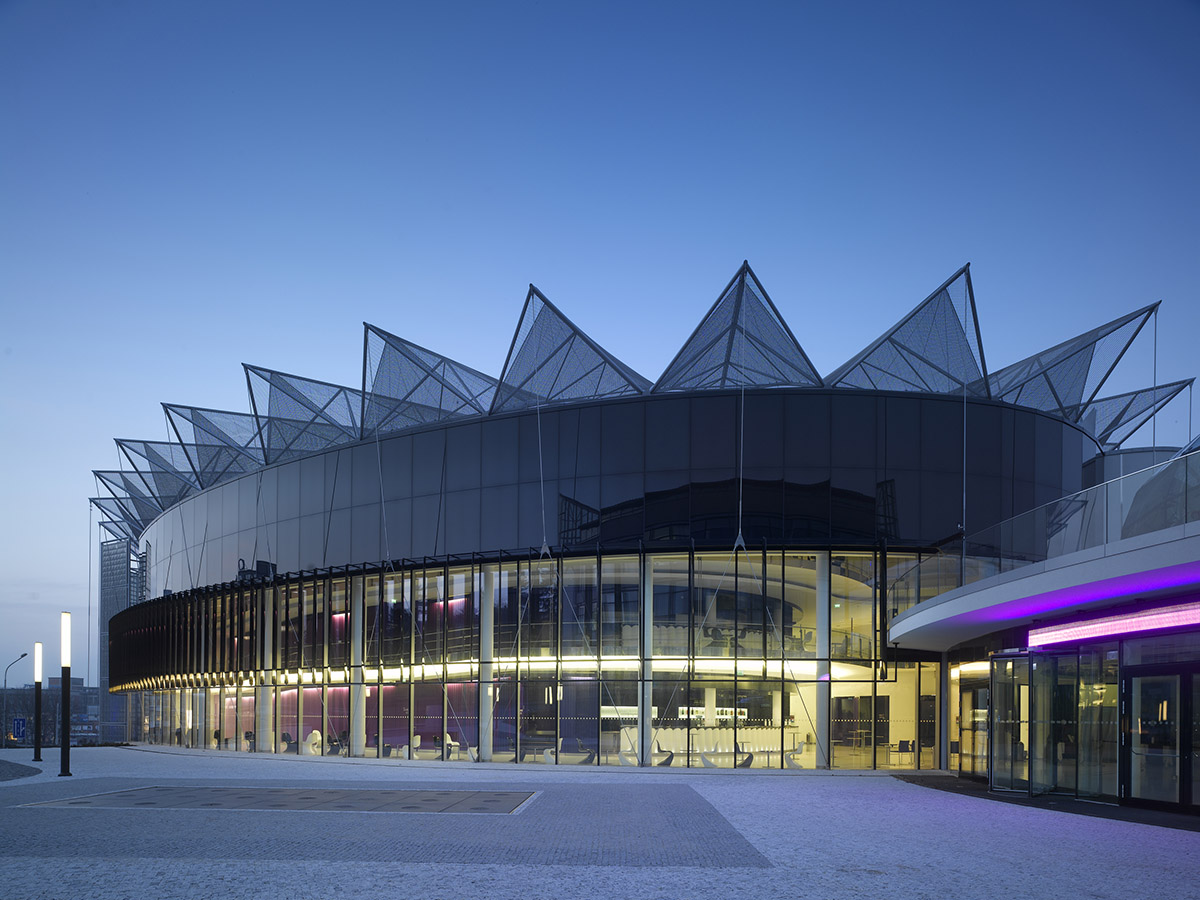
Congress Center, Zlín designed and completed by AI DESIGN in 2011. Image © Richard Davies
"Future is something which you prepare the stage for somebody else to play the role of the next stage," said Jiřičná.
"There is a great pressure to go in that direction, but I think we are human beings and we have emotions. Whatever we talk about smart technologies, new datas or artificial intelligence, I see the human brain is still a product of the nature and nature doesn’t eventually fail."
"We should use technology to be able to regenerate our way of living. The way how we live now and I see we have so many objects which we don’t need. We have such an enormous waste," she continued.
"We just need to understand what we are doing in general through the technology day by day."
"You have to save every single material which you touch or you put in your hand, but you don't need to worry how complicated it is to make those buildings because you are actually giving it to people," added Jiřičná.
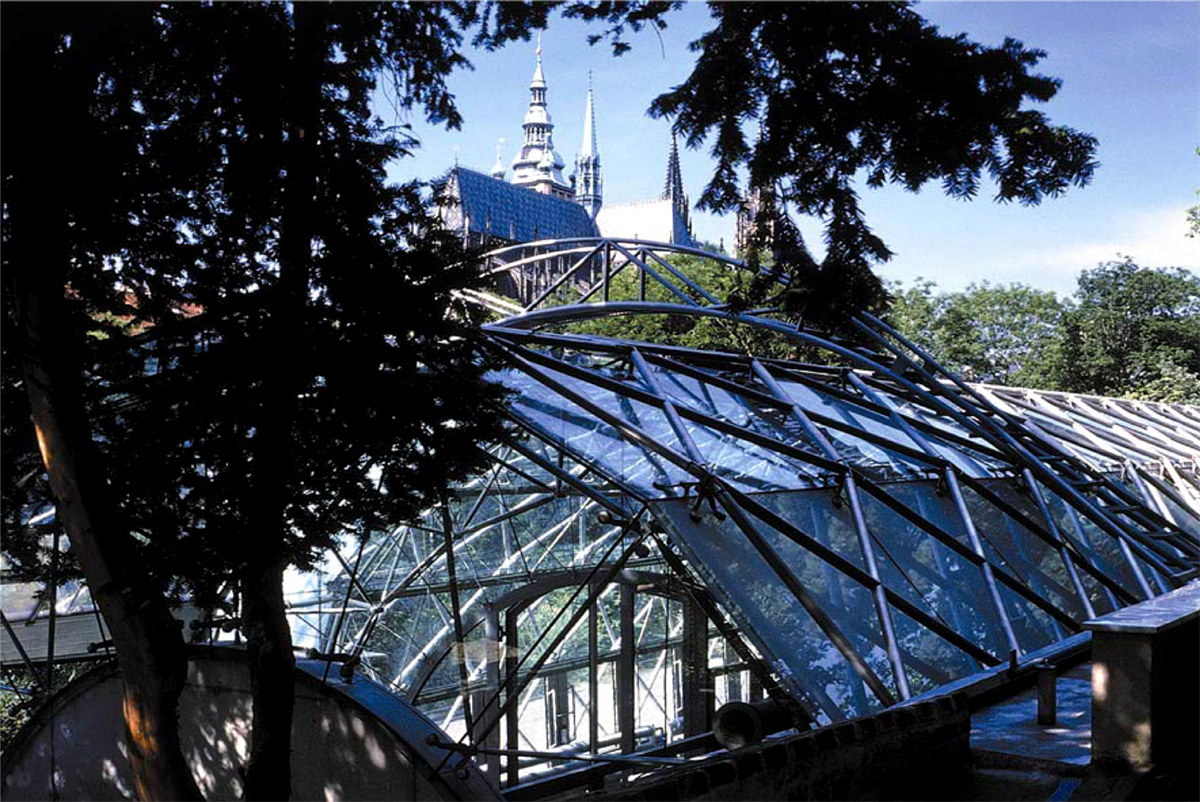
Prague Castle Orangery designed by Eva Jiricna Architects Limited in 1998. Image © Pavel Štecha
Eva Jiřičná, 80, is a Czech born architect based in London. She studied engineering and architecture until 1962, gaining a Master’s Degree at the Prague Academy of Fine Arts. She moved to London in 1968, working as an architect with the Greater London Council. A year later, she became an associate in the Louis de Soissons Partnership, and later joined Richard Rogers, before forming her multidisciplinary practice, Eva Jiricna Architects, in 1982, operating until 2017.
Twenty years ago she opened the office AI DESIGN with the Czech partner Petr Vagner in Prague in 1999. She is known for her retail, residential interior projects, the interiors of shops, as well as mainly glass staircases. AI DESIGN’s portfolio also includes university buildings, hotels, housing and cultural buildings.
The Brighton Marina project and the Lloyd’s Building – Jiřičná worked with Richard Rogers on the project, are among the projects define her career.

The Lloyd’s of London by Rogers Stirk Harbour + Partners (RSHP) completed in 1986. Image courtesy of RSHP
Jiřičná won multiple prestigious awards for her contribution to architecture and design, including the title Royal Designer for Industry (RDI) and Commander of the British Empire (CBE).
She is a member of the Royal Academy of Arts, an honorary fellow of the American Institute of Architects (AIA) and an honorary member of Royal Society of Arts.
She won the 2013 Jane Drew Prize for her outstanding contribution to the status of women in architecture, and Jiřičná was described by judges Zaha Hadid and Rafael Vinoly as “incredibly influential” and “extraordinary”. Jiřičná has received eleven honorary doctorates, was awarded the Lifetime Achievement Medal by the London Design Festival and was named an Ambassador of the Czech Republic by the Czech Top 100.
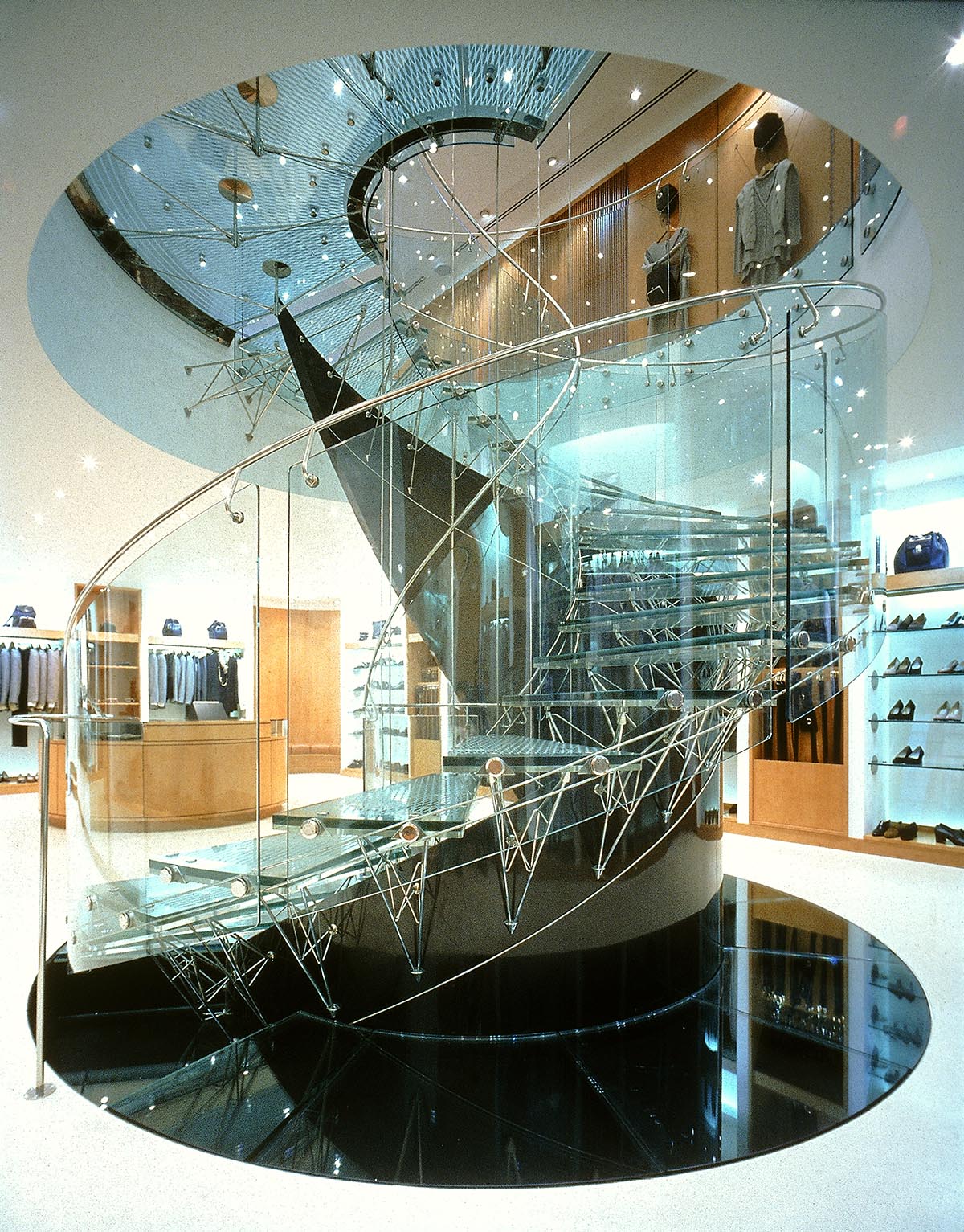
Joan & David, New Bond Street, London completed in 1995, designed by Eva Jiricna Architects Limited. Image © Richard Bryant/Arcaid
The Bollinger Jewellery Gallery in V&A, Canada Water Bus Station, Leicester Library, Orangery at Prague’s Castle, the Congress and University Center in Zlín and most recently Educational Complex of Thomas Bata University in Zlín are among her well known projects.
The AI DESIGN studio is currently working on several residential buildings both in Prague and Brno, then Auditorium for Thomas Bata University in Zlín, as well as on the winning project New Zizkov Centre in Prague.
Read the full transcript of our interview with Eva Jiřičná below:
Berrin Chatzi Chousein: Prague is actually your hometown. Your are the Czech architect and but then you moved to London in the 1960s. Could you please tell us about your architectural journey that forces you to move to London? What were the radical reasons behind your decision?
Eva Jiřičná: There was absolutely no forcing to move to London. This was valid for any young person who tries to get experience abroad. We were in Prague and we had no so much experience because we were students and couldn’t travel abroad. We could only travel to socialist countries for holidays. I could speak Russian so I was sent to Moscow for an exhibition as an interpreter. But all our travel choices were limited to what was called for the countries behind “the Iron Curtain”. But we were always dreaming to see the west world – for example London was one of them, we knew about it, we heard about it but we couldn’t see it.
There was a congress of architects in 1967 in Prague, I met with Deputy Architect of GLC (Greater London Council), was a big organization of architects - which doesn't exist anymore. But in London, it was a kind of controlling the post-war development of architecture, all the famous architects worked for that organization. When the Deputy Architect came to see my office in Prague, we were working on a kind of research project for the system buildings of a primary school. So he said: “oh it would be such a good idea to do an exchange it”. So he said: “why don't you come to London for a year and we will send a British architect to Prague”.
And I was delighted but due to the political system it took me a year to get a passport, to get permission, to leave the country. So when I eventually arrived in 1968, I had absolutely no idea and it was only 3 weeks from the invasion. After invasion, I received a letter from Czech Embassy, saying that they didn’t want me back and my passport was abolished. My mom later on was told the reason of that - because I was a member of the society for the protection of human rights. Yes, I was a member but to be honest I had no idea what it was. I wouldn’t have done it if I did know but I had no idea what was so terribly dangerous about it, but of course, it was an international organization.
So that was the first part of the story. Then Václav Havel was elected as a President and he started doing all the changes, the country started changes. I was offered to start to work on a couple of projects in Prague. Initially I didn’t think it was a good idea because all my friends had no opportunity to work on such projects - when I was getting experience and working on magnificent projects, meeting with fantastic people. But some of the works were really and only for people who work abroad. So we started doing projects under consulting, like in Frank Gehry’s building - The Dancing House in Prague. So eventually with my partner Petr Vágner – who was actually a student and worked in our London office for a while – we started to establish our office 22 years ago. So since then, I'm just oscillating between London and Prague.

Canada Water Bus Station, London designed by Eva Jiricna Architects Limited and completed in 1998. Image © Richard Bryant/Arcaid
Berrin Chatzi Chousein: When you first came to London, what were the challenges that you faced with your architecture practice?
Eva Jiřičná: First challenge for me was using a fluent English. You arrive the airport and there is a Scottish girl sitting there and coming to say something and you have absolutely no idea about what she is saying. And you realize that you need to learn fluent English because the language of English has so many different faces and it takes you sometime to be able to communicate properly, so that is the first challenge. So I completed my all courses organized by the British Council. But in the meantime, I was actually working with the Business of GLC which was a big office and was full of foreigners. And of course, I didn't realize and I always saw that the Czech education was really mediocre. But I realized that the Czech education was still a continuation of the period between the Two World Wars.
And the Czech Republic was a highly industrialized country and our education was by people who have themselves trained abroad, they studied in Paris, Germany, etc. They were students in Bauhaus and they were teaching in Bauhaus and all of these people actually participated on teaching me. Suddenly I felt like a king because I knew how to draw, I know a little bit about structure engineering, I know a little bit about environmental engineering and so on. I was actually very useful person to work even if my English was very limited. So I just started getting jobs and being offered jobs which I never tend to. And the next job was working on the largest project in England which was the project of the Brighton Marina.
"Richard Rogers’ office was another fantastic school for me"
The Brighton Marina project came to the end and finished because the recession started in 1978 and the Brighton Marina company couldn't continue. So I started working for Richard Rogers’ Lloyd's Building in London - Richard Rogers’ office was another fantastic school for me, and that office was as inventive as you can possibly imagine in 1980. In 1984 the project finished and I started to work on my own company because I started to contact with some people who want to convert some shops or department stores because there were no shops at that time. Shops are a kind of a matter of our daily life. But in that time no architects designed shops because they were not a kind of attractive field for an architect. But they were also swinging in London for an international scene. Somehow America or London has a very closed content. I suddenly became a part of professional circle which was truly amazing and also international.
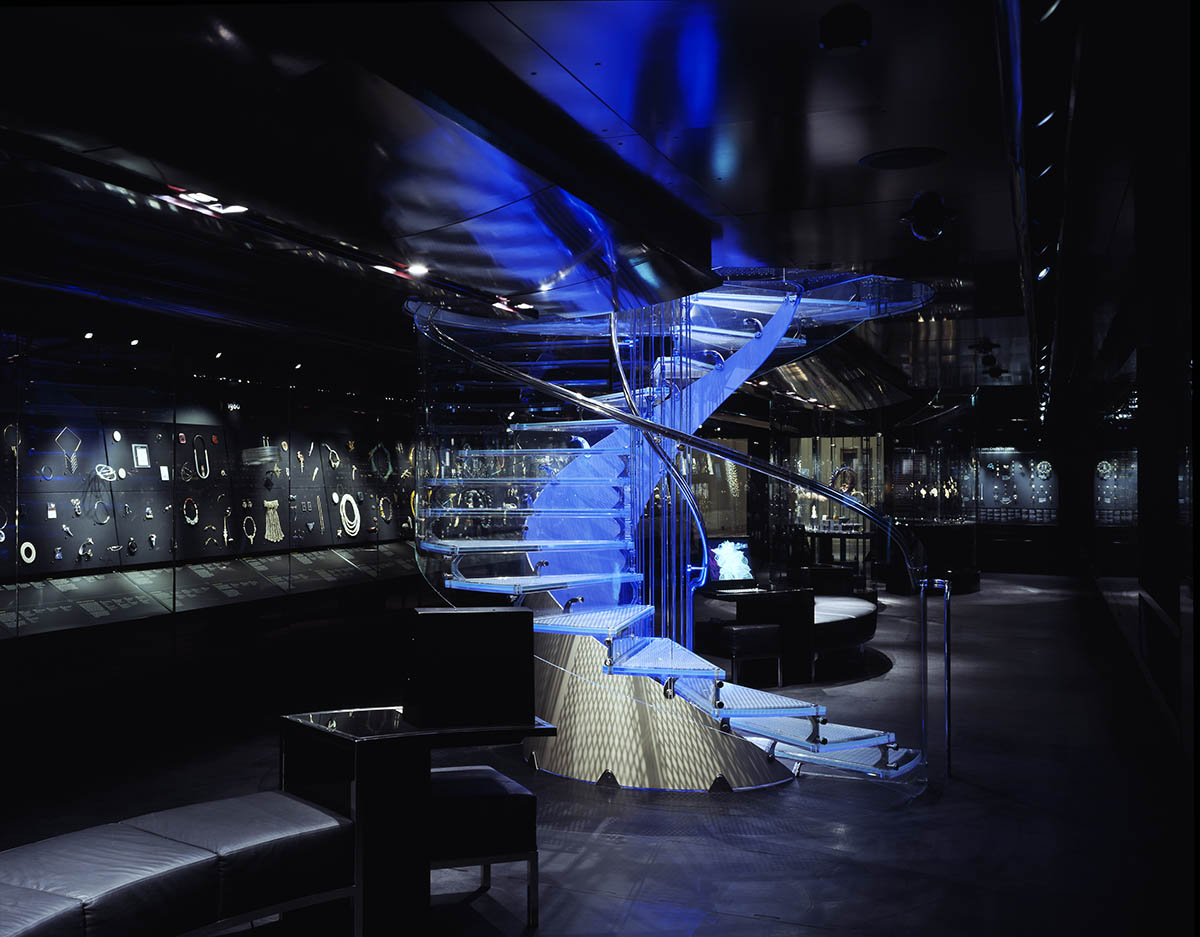
The Bollinger Jewellery Gallery at the Victoria & Albert Museum, London completed in 2008, designed by Eva Jiricna Architects Limited. Image courtesy of AI DESIGN
Berrin Chatzi Chousein: How was your experience while working with Mr. Rogers during that period? Do you think that working with such a global office affected or contributed to your current architectural practice?
Eva Jiřičná: First I should say the office was working on the most important projects like the Lloyd's Building at that time. Secondly, being a part of the team was amazing because I knew him and was helping to Richard Rogers when he was doing the exhibition for the Centre Pompidou in Paris so I spent two nights and two days in the office by working on his drawings. I knew him when I first came to England. But it was extremely friendly office and that office was really trying to be as inventive as possible. They were really trying to change the world with new materials and new technologies. But I think collaboration with all the technical team, with architects as one design team, was very new. I worked two and a half years in the office then I took a couple of jobs from the Lloyd's Building. Then I started my own office. But we are good friends now and ever since.
But you know, it's a certain point in your life you need to have different experiences. Then I immediately started my own office as Eva Jiricna Architects in 1982. Then I founded AI DESIGN (Architecture Interior DESIGN) with my partner Petr Vagner in Prague in 1999.
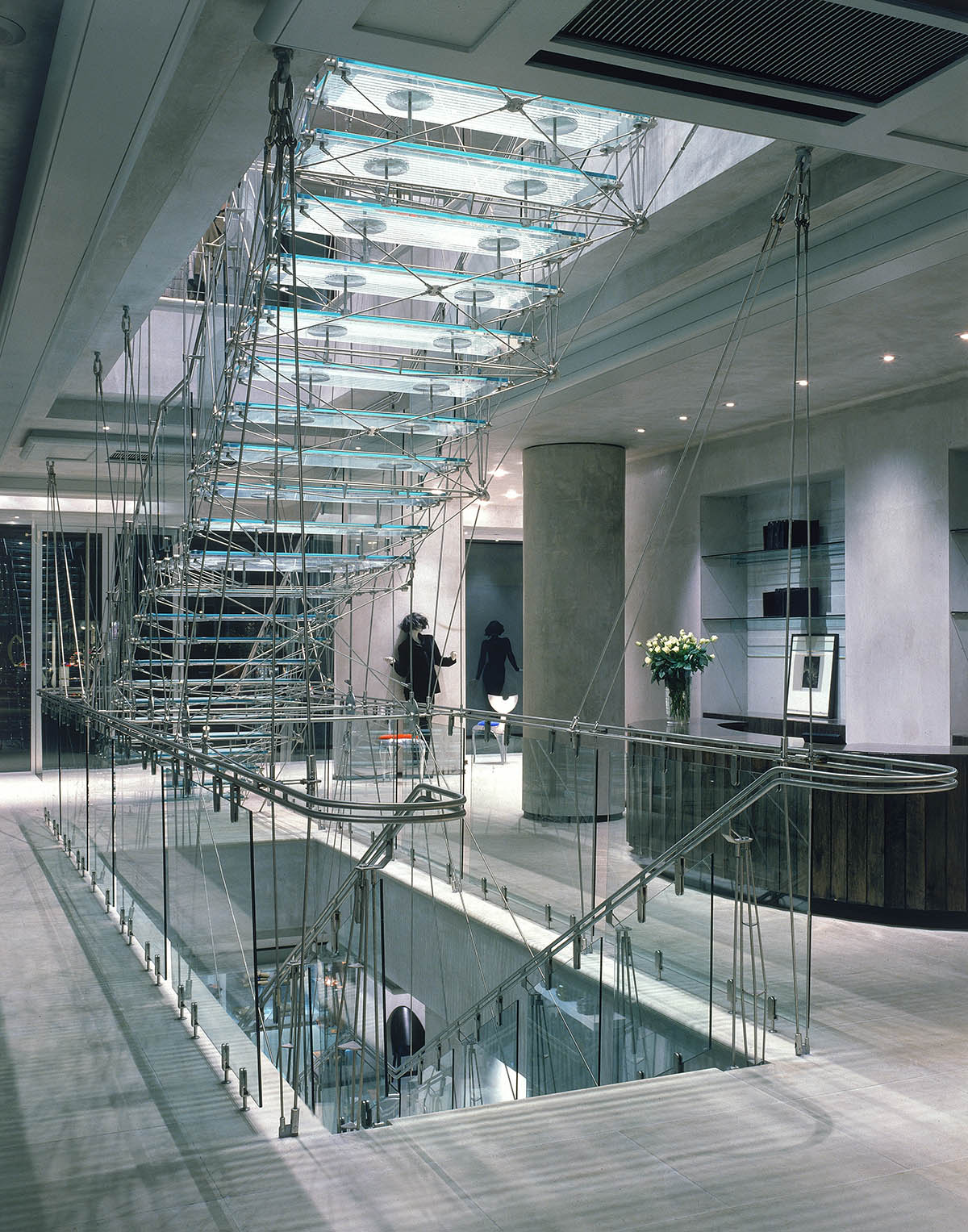
Joseph, Sloane Street, London completed in 1989, designed by Eva Jiricna Architects Limited. Image courtesy of AI DESIGN
Berrin Chatzi Chousein: When I examine your projects separately, each of them tells something different to me, because you describe yourself as “multidisciplinary” office, producing interiors, large-scaled buildings, residential projects or office buildings. But how would you describe the office’s architectural approach in general?
Eva Jiřičná: When I started to work in my own office, we started finishing the interiors of the Lloyd's Building. In the meantime, we were asked to design the interior of the biggest department store, named Harrods Department Store, in London. Then I started to design shops for Joseph Ettedgui - Joseph was a Moroccan retailer but he was an extremely brilliant guy and he just throw the idea of architects working retailers and creating the environment for the new dimension to be solved. He wanted to create the environment suitable to sell the product and to build something on the philosophy of the fashion design.
But you have to somehow produce a kind of architectural stage for this. We had the project brief and the brief was to create a flavor of the fashion designer who is going to be put on this stage. But you also have to put all the actors in that stage and make them to play with all the flavors and reflect the message what is it about – because fashion has suddenly become a new chapter in people’s life.
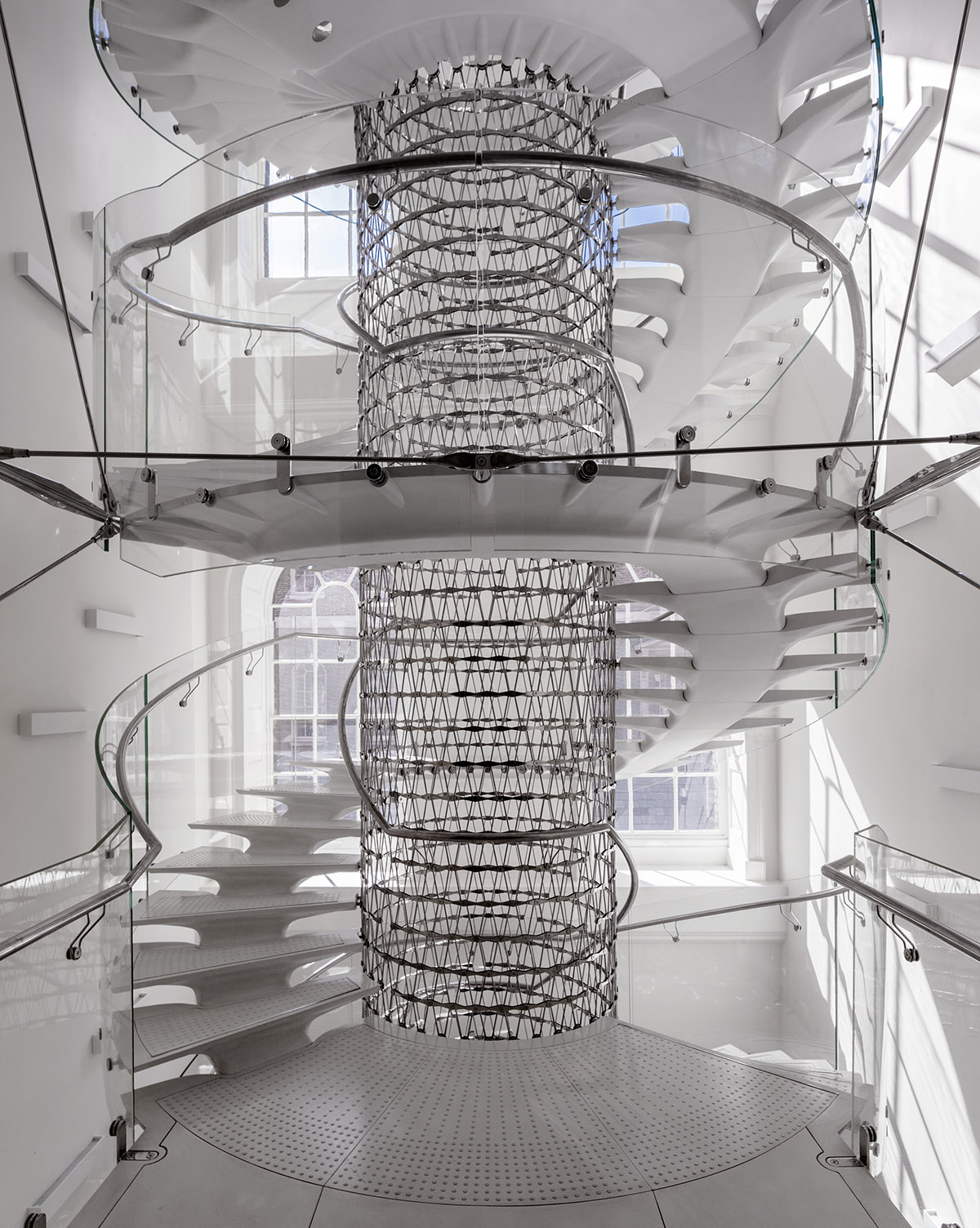
The elegant Miles Stair inside the Somerset House, London - a neoclassical building from 1776, designed by Eva Jiricna Architects (2016). Image © Peter Cook
Berrin Chatzi Chousein: Many architects have now begun to go beyond their well-grounded discipline by going beyond designing a structure. They invest technology, they start to design a luxury boat, or a sustainable product, or even they design new materials for buildings. Even you describe yourself as a “multidisciplinary” office, but do you think an architect is forced to operate in every discipline with the new technological innovations brought by the age of technology?
Eva Jiřičná: I see some architects taking technology in the center of their philosophy, and some of them don’t do this. But this doesn’t mean that the architects dealing with the technology are good architects and others are not. Architecture is a profession giving you very wide limits between you can oscillate. And how determined the past between those limits, which are very widely spread, is up to you. So you can just be obsessed with this technology, maybe by looking at the architecture of Nicholas Grimshaw. He is partially a victim of the technology. He is a brilliant architect designing fantastic buildings. But for him the technology is something which is the main element in his work. I was also trained as an engineer architect and I'm fascinated by the technology.
"I can’t somehow keep technology for myself or can't incorporate it in everything what we do"
We are living in a world which is full of invention and so many things are changing. I can’t somehow keep technology for myself or can't incorporate it in everything what we do. You have to somehow focus on the future because the present doesn’t exist in this moment in the history. Future is something which you prepare the stage for somebody else to play the role of the next stage. But architecture is always about the modesty and discipline. You have to really work on it but not for your own ego – because your ego will be forgotten. But it is just about preparing the grounds for the next step.
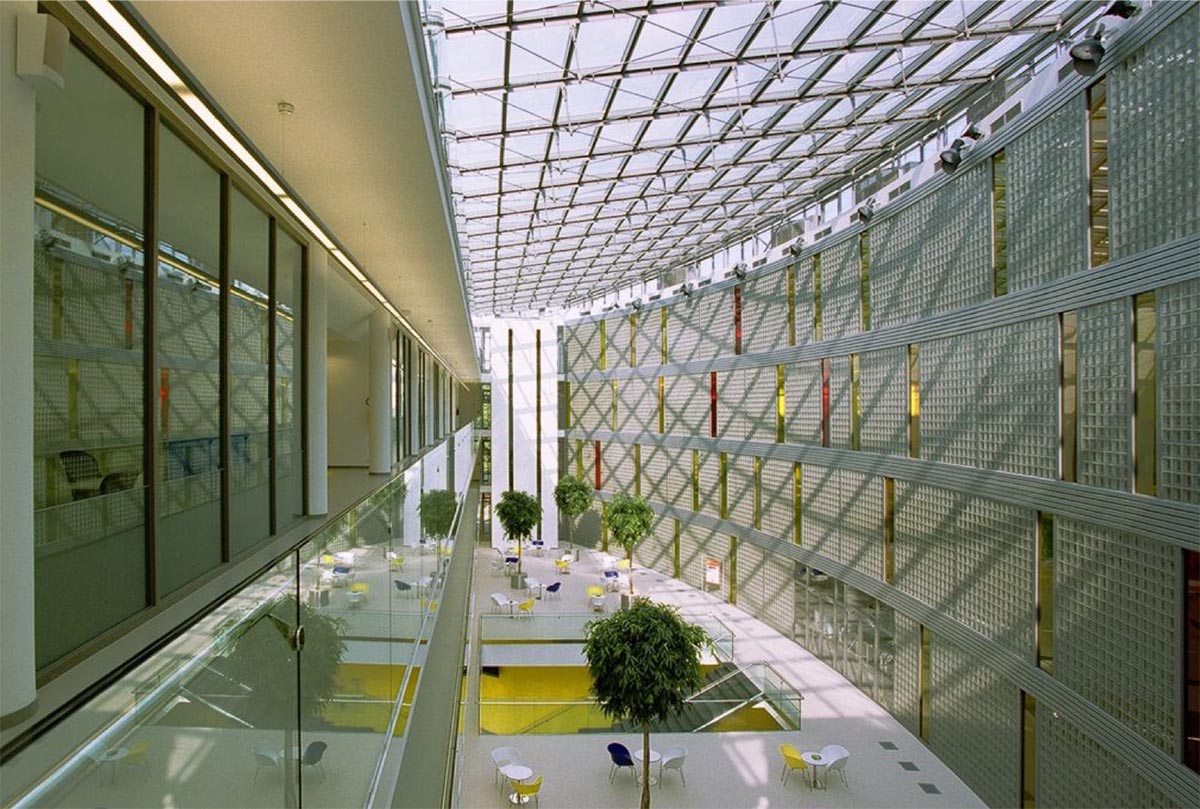
Tomas Bata University, Library Building, Zlin completed by AI DESIGN in 2008. Image © Ivan Nemec
Berrin Chatzi Chousein: reSITE’s theme is REGENERATE this year. How do you evaluate the future of the cities?
Eva Jiřičná: There is a great pressure to go in that direction, but I think we are human beings and we have emotions. Whatever we talk about smart technologies, new datas or artificial intelligence, I see the human brain is still a product of the nature and nature doesn’t eventually fail. We should use technology to be able to regenerate our way of living. The way how we live now and I see we have so many objects which we don’t need. We have such an enormous waste. We just need to understand what we are doing in general through the technology day by day. My father was also an architect and it didn’t worry him how much material he used in the project which he produced because nobody even mentioned it. Architects did not use structural engineering to minimize the amount of material which you need to produce structures. If I will design a structure that includes four columns and a piece of slab and if I make it bigger and safer, we can use the science to find out what is absolutely the minimum size of these columns, or materials – which allows us to save the material.
You have to save every single material which you touch or you put in your hand, but you don't need to worry how complicated it is to make those buildings because you are actually giving it to people.
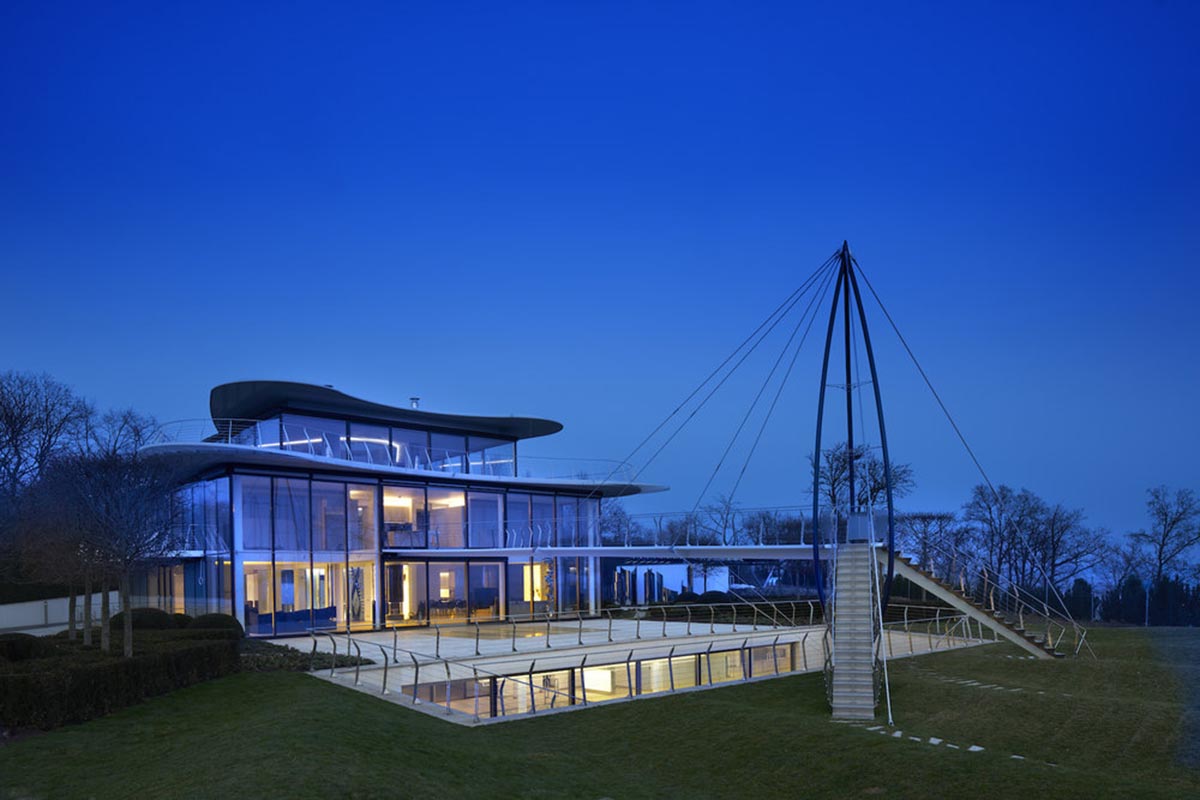
Villa, Prague completed by AI DESIGN in 2018. Image © Richard Bryant/Arcaid
"I have to create my philosophy, or the idea of aesthetic or the complexity of the project on a piece of paper by hand"
Berrin Chatzi Chousein: Where do you mostly take your inspirations? An architectural movement, music, a film, calmness, vacation…How do you start to objectify your imagination on the paper or computer?
Eva Jiřičná: I use computer as a simple tool – I think if you compare it with a carpenter it would be like a hammer, anybody can pick it up and hit something. Computer to me is a good idea because I have to use it, I can’t avoid using it. But I can’t draw or design on the computer. I have to take a pencil, a piece of paper and my brain and I have to let the communication between my brain and my hand.
It shouldn’t be interrupted by the computer. After I have got an idea, then if there is everybody else at the office – because technically they are faster than me – so they put it on the computer. But I have to create my philosophy, or the idea of aesthetic or the complexity of the project on a piece of paper by hand. Sometimes you learn how to do it in a sleepless night without a piece of paper but that is you can’t rely on it – because you only realize it when you see it in reality.
I know people who work on the computer but I do examine huge amount of students because I'm an external examiner in all quite a number of schools. And I know that if a student has got a really brilliant project, they usually do a lot of sketches. So I still believe that our hands - as the nature develops them, the brain can really communicate much better. But they have hands that are capable to make this machine function properly.
You learn to do it through your brain, but of course, machine helps you – you print it and show it somebody and share the experience. If I can’t draw the complexity of the project, on the other hand if I use the pencil and communicate with the client, I draw and I can actually take him into the process of my proposal on the way of thinking, it is much easier than showing them the final product - because you cannot have this kind of advantage on the computer. You can make a beautiful house that has good windows and doors on the computer. But it is not designed, but that process works in every single detail and consideration – for example, how much is going to cost? can you turn the door? so on...You have to go back and then design it and design the changes again.
But if you take people through the process and if you take them through the journey, you can show whether something can be done or not – because mainly the clients ask you through something which is usually either silly or impossible. And you have to somehow identify where it is coming from because they have got dreams or they have got a kind of incomplete vision. Through questioning you have to find some routes how they arrive and their wish emerges, because the clients are not architects and as an architect, you have to identify the vision through the process.
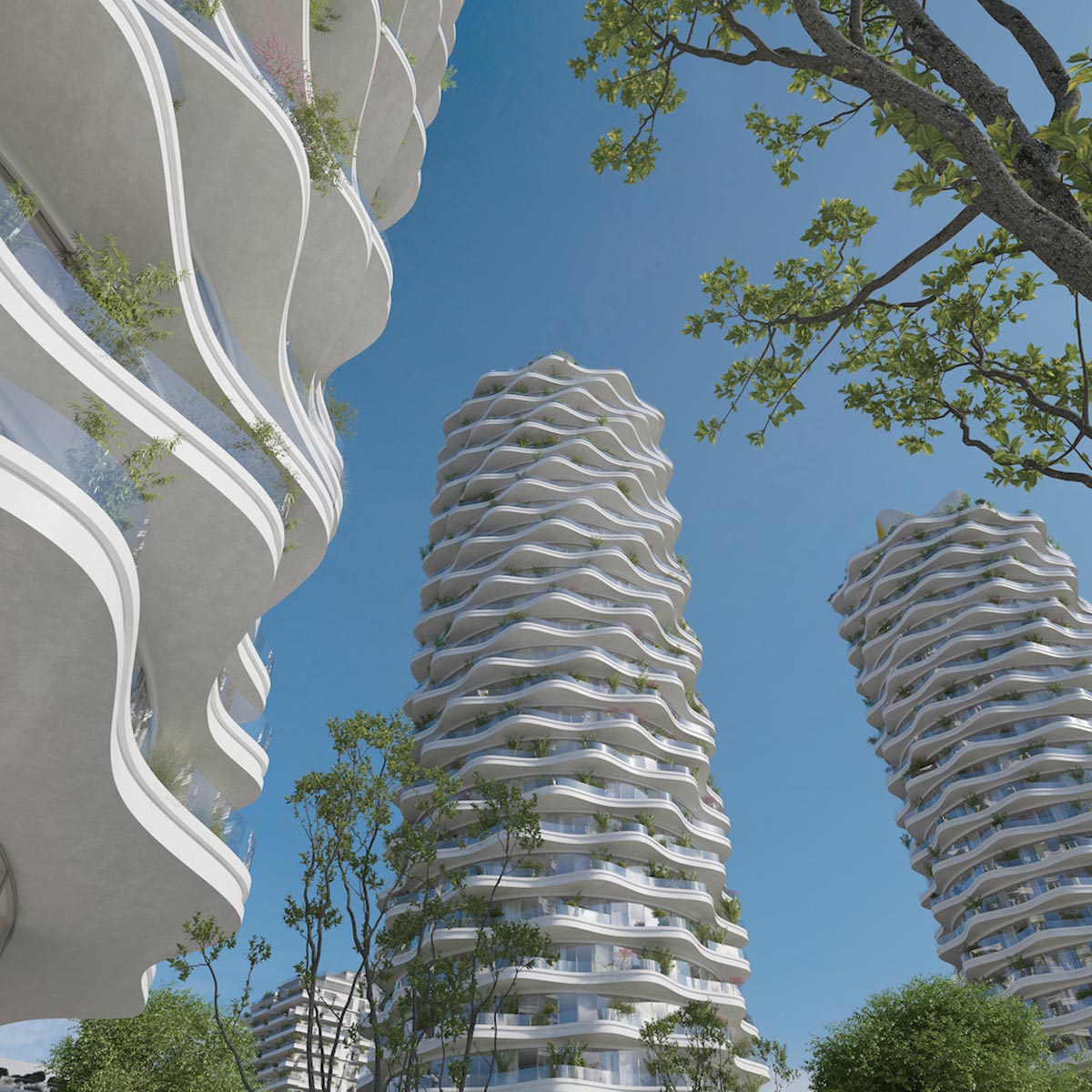
AI DESIGN is working on a new project, "Living with Waves" - New Zizkov Centre, the competition winning project with Central Group - a complex of buildings to be built on the site of the former Telecom called Mordor in Prague 3, Žižkov. Image courtesy of AI DESIGN
Berrin Chatzi Chousein: You are using too much glass and steel in your projects, especially your glass staircases are like a fashion or sculptural object. What is the importance of glass for you?
Eva Jiřičná: I think it is about coming across with the production of glass in a very early stage. My grandmother came from the North of Czech Republic and they were producing glass, bricks and I just fell in love with the material because of the light – what does the glass do with the light? how is it working with different lights? and so on. When I was nineteen years old, I was sent to a Russian grammar school and I learned Russian. There was a Czech exhibition in Moscow and we had to learn about the production of glass and go to the artist studio.
"Glass gives you a possibility of extending the spaces"
So I actually saw what the artists do with glass which was a magnificent product. I also saw the production of technical glass – like bottles, cups - which was something that you put in your brain in the 1956s. And you realize that you can’t just throw it out because somebody else can reuse it. When I started designing interiors, I suddenly realized that what could be the role of glass in the interior spaces. Due to its transparency or reflectiveness, it creates a kind of see-through base – it is much more clean and hygienic. It gives you a possibility of extending the spaces. So I started working with structural engineers and together we just started doing on how we should bring the light into those spaces where there is no light – like basements. Then we become fascinated by the technology, because initially the glass was just the material which breaks or not safe enough.
Berrin Chatzi Chousein: You are mostly designing in the Czech Republic. Right? Do you have new projects in London?
Eva Jiřičná: We have just finished and redesigned a jewellery gallery. It was completed ten years ago but it needed an update because the technology and many things change and we had to accommodate a few new objects. We have completed a new gallery in Prague from the London office. We have designed a couple of shops for a company who sells jewellery. And we are currently working on two more shops – one of them is designed for electrical appliances and another is designed for a kind of artificial marble, and we have been designing two houses in Prague as well. The London office is mainly for more interior and small-scale projects but in Prague we are doing buildings and large-scale projects. Prague is a big corridor for these kinds of big schemes.
Top image: Eva Jiřičná, co-founder and director of AI DESIGN. Image © Matej Slávik.
(end of the transcript)
